For a long time, the study of the female prison population, the treatment of female prisoners and the living conditions in women’s prisons was marginalized. This is due to the fact that women have always constituted a much smaller part of the total prison population. And yet, the history of women’s prisons shows that there have always been differences between institutions for male and female convicts, which has been visible in Serbia, too.
The only institution in Serbia where the prison sentence imposed on adult women and female older minors, both for criminal offences and misdemeanours, is executed is the Correctional Institution for Women in Požarevac.
The history of women’s prison in Serbia
The correctional institution for female prisoners has been located in Požarevac since 1866, when it was transferred by the Decree of Miloš Obrenović from the state prison in Ćuprija, where women were serving prison sentences.[1] At first, women’s prison in Požarevac was located near the Miloš barracks, which housed the men’s prison. Construction of the women’s prison began on June 17, 1874, while the convicts were engaged in construction work. The building was built on the site where the women’s prison is still located today. Women were imprisoned in that building for a century and a half – from 1875 until the second half of 2022, when it was demolished.
The Correctional Institution for Women in Požarevac began operating in 1875. At that time, there were 38 female convicts in it. As stated by Milutin A. Popović in the book Female prisoners – Album of the Women’s Department of the Požarevac Penitentiary (1898), the prison was organized according to the principle of joint execution of the prison sentence. The building itself housed rooms for convicts (ten in total), craft workshops – two for knitting, one for embroidery and one for carpet making; a hospital, a waiting room, an apartment for the supervisor and guards, a kitchen and offices, as well as a room for solitary confinement. According to his words, the women’s prison was significantly closer to the standards of the modern penal institutions of that time.
Women’s prison today
Correctional Institution for Women is located almost in the centre of Požarevac, near the bus station, next to the railway line. The institution is surrounded by high walls, which for many years has not been in line with positive regulations. According to the provisions of the Law on the Execution of Criminal Sanctions of the Republic of Serbia, the Correctional Institution for Women is a semi-open institution. In accordance with Article 14 of the Law, in this type of institution, the main obstacle to escape is the security service. Therefore, although there are open, semi-open and closed departments in the institution, and they differ according to the level of security and the manner in which convicts are treated, all women actually serve their prison sentence in a closed institution.
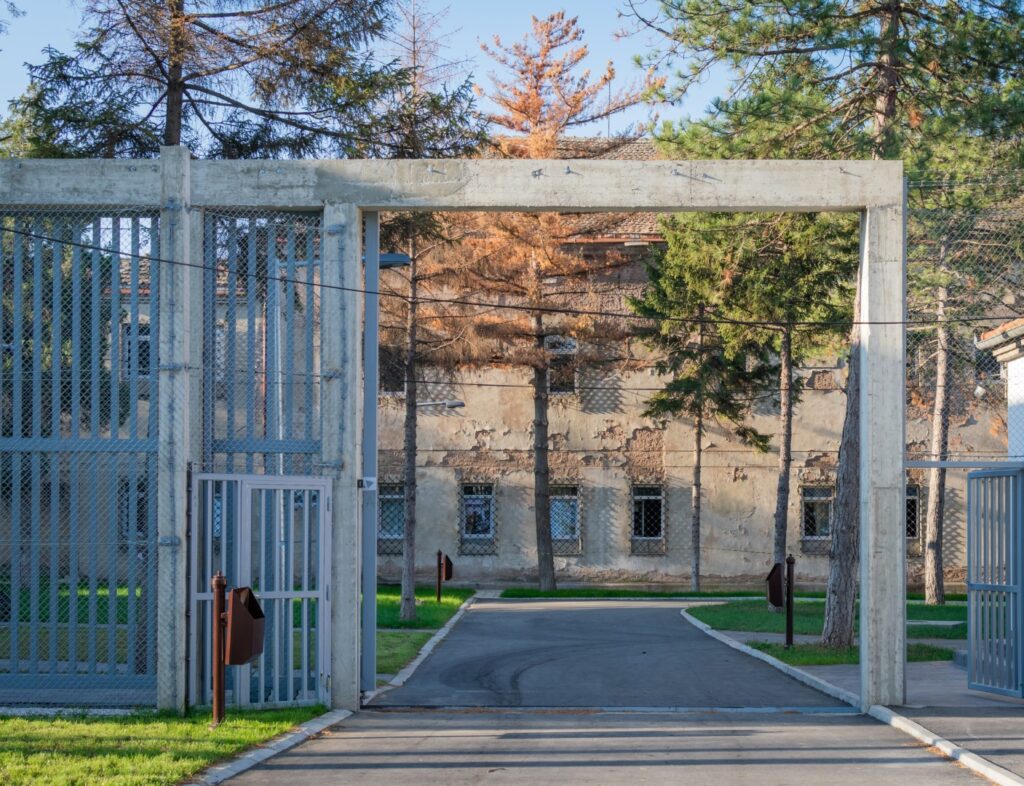
Photography 1: Penal-correctional institution for women in Požarevac. Author: Ana Batrićević. The photograph was made for the purpose of research about the greening of prison communities, the results of which were published in the book: Pavićević, O. Ilijić, Lj., & Batrićević, A. (2020). Susret društvenog i biološkog ozelenjavanje zatvorskih zajednica. Belgrade: Institute of Criminological and Sociological Research.
Until 2022, there were two pavilions for the accommodation of female inmates. The main pavilion for the accommodation of convicts dated back to 1875. Female prisoners housed in it were divided into closed and semi-open wards. In the courtyard there is also a smaller, ground-floor building, where previously female prisoners were placed in an open department, while today there is a reception department and accommodation for women convicted of misdemeanours. As part of the work on the reconstruction of the institution, in 2019, a new building for female inmates was built. The plan is to use this building for accommodation of female inmates who have been assigned to semi-open and open wards, so that when the reconstruction of the institution is completed, these wards will no longer be inside the walls.
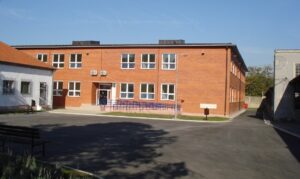
Photography 2. New pavilion in the Correction Institution for Women in Požarevac. Author: D. Novković, Večernje novosti, retrieved from: https://www.novosti.rs/vesti/srbija.73.html:824167-Pogledajte-kako-izgleda-novi-objekat-zenskog-zatvora-u-Pozarevcu-FOTO, page accessed: 10.04.2023.
Until the reconstruction of the women prison is completed, the new building accommodates female prisoners assigned to all three departments. Thus, at the moment part of the building are adapted to accommodate female prisoners who are assigned to a closed department (for example, locking the part of the corridor in which the closed department is situated, bars on the windows of rooms, etc.). On the other hand, a new building will be built on the site of the old main pavilion, which will be used to house female inmates assigned to a closed department, so it will be separated from the rest of the institution by a high fence and a wall from the outside world. The building will have the capacity to accommodate 226 women.
The newly built facility for housing female prisoners has a capacity of 160 places. It is divided into blocks, and each block has rooms to accommodate between 4 and 10 women and a living room with a kitchenette. Each room has a bathroom, which is a significant change compared to the accommodation in the former old pavilion, where there were shared bathrooms that were not sufficient for the number of convicts. In the new building, there are special rooms with washing machines where female prisoners can wash not only the prison uniform they use for work and bed lenient, but also their private belongings, which was not the case in the past. The building also has an ambulance, hairdressing room, a library, a room for physical exercises and organising different workshops, a classroom, and a room for free activities (embroidery, painting, mosaics, etc.). The building, including its entrance, is adapted for female prisoners with disabilities.
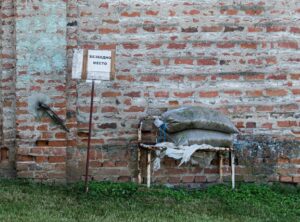
Photography 3. Details from the garden in the Correctional Institution for Women in Požarevac. Author: Ana Batrićević. The photograph was made for the purpose of research about the greening of prison communities, the results of which were published in the book: Pavićević, O. Ilijić, Lj., & Batrićević, A. (2020). Susret društvenog i biološkog ozelenjavanje zatvorskih zajednica. Belgrade: Institute of Criminological and Sociological Research.
There is also a dining room with a canteen where female prisoners work. However, there is still no central kitchen within the prison; the food is prepared and brought from the Correctional Institution for adult male prisoners in Požarevac – Zabela. This was assessed as inadequate in numerous reports of the Protector of Citizens and civil society organizations; central kitchen in the women’s prison would contribute to the female prisoners’ professional training and employment, which is relevant for their treatment and preparation for release.

Photography 4. Details from the garden in the Correctional Institution for Women in Požarevac. Author: Ana Batrićević. The photograph was made for the purpose of research about the greening of prison communities, the results of which were published in the book: Pavićević, O. Ilijić, Lj., & Batrićević, A. (2020). Susret društvenog i biološkog ozelenjavanje zatvorskih zajednica. Belgrade: Institute of Criminological and Sociological Research.
There is also a working facility, where female convicts are employed in tailoring and sewing, and there is also a home-made workshop where a number of jobs are performed as a service for third parties. Female convicts are also engaged in vegetable growth in the garden and greenhouse. The vegetables are used in the diet of female prisoners (for example, to prepare salads), but they are also sold, and the money is used for the needs of the institution.
In the prison complex, there is also a hospital where female prisoners who need health care are accommodated, a room for family visits and a reception department and accommodation for women who have been punished for misdemeanours. Finally, in accordance with relevant provisions, pregnant women and mothers with children are accommodated in a separate part of the building where the hospital unit, ambulance and the room for family visits are located, thus, separate from other convicts.
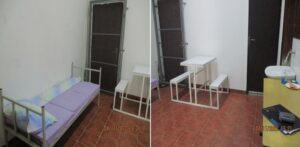
Photography 5. Premises for family visits on the Correctional Institution for Wmen in Požarevac. Source: Izveštaj o poseti Kazneno-popravnom zavodu za žene u Požarevcu Beograd, decembar 2022. godine, Zaštitnik građana, 2013. Retrieved from https://www.ombudsman.rs/attachments/article/7560/Izvestaj.pdf, page accesses: 10.04.2023.
A look into the future
The Correctional Institution for Women has been located in the same place for a century and a half. The old accommodation building was renovated only twice during that period (in 1911 and 1971). This has resulted in very poor conditions for women serving prison sentence, while continued poor living conditions, along with other factors, including overcrowding, can lead to treatment that can be characterized as inhuman and degrading. That is why the progress made with the construction of a new facility for the accommodation of female prisoners, as well as the overall work on the reconstruction of the institution, is very important. It will contribute to harmonizing the actual situation with positive regulations, but at the same time it will improve the living conditions for women and the level of respect for the human rights of female convicts, which are, inter alia, an important element of the modern concept of the quality of prison life.
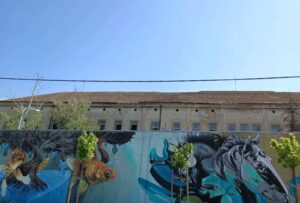
Photography 6. Details from the outside wall of the Correctional Institution for Women in Požarevac. Author: Nikola Drndarević
Prof. dr Sanja Ćopić
[1] Popović, M. (2017) Zatvorenice – Album ženskog odeljenja Požarevačkog kaznenog zavoda (1898). Beograd: Laguna.
